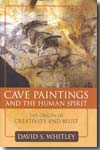Cave paintings and the human spirit
the origin of creativity and belief
- ISBN: 9781591026365
- Editorial: Prometheus Books
- Fecha de la edición: 2009
- Lugar de la edición: New York. Estados Unidos de Norteamérica
- Encuadernación: Cartoné
- Medidas: 24 cm
- Nº Pág.: 322
- Idiomas: Inglés

The magnificent prehistoric art discovered in caves throughout France and Spain raises many questions about early human culture. What do these superbly rendered paintings of horses, bison, and enigmatic human figures and symbols mean? How can we explain the sudden flourishing of artistic creativity at such a high level? And in what ways does this artwork reflect the underlying belief system, worldview, and life of the people who created it? In this fascinating discussion of ancient art and religion, Dr David S Whitley - one of the world's leading experts on cave paintings - guides the reader in an exploration of these intriguing questions, while sharing his firsthand experiences in visiting these exquisite, breath-taking sites.To grasp what drove these ancient artists to create these masterpieces, and to understand the origin of myth and religion, as Whitley explains, is to appreciate what makes us human. Moreover, he broadens our understanding of the genesis of creativity and myth by proposing a radically new and original theory that weds two seemingly warring camps from separate disciplines. On the one hand, archaeologists specialising in prehistoric cave paintings have argued that the visionary rituals of shamans led to the creation of this expressive art. They consider shamanism to be the earliest known form of religion. By contrast, evolutionary psychologists view the emergence of religious beliefs as a normal expression of the human mind. In their eyes, the wild and ecstatic trances of shamans were a form of aberrant behaviour.Far from being typical representatives of ancient religion, shamans were exceptions to the normal rule of early religion. Whitley resolves the controversy by interweaving the archaeological evidence with the latest findings of cutting-edge neuroscience. He thereby rewrites our understanding of shamanism and its connection with artistic creativity, myth, and religion. Combining a colourful narrative describing Whitley's personal explorati






